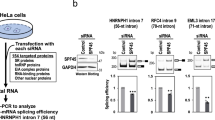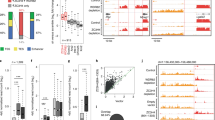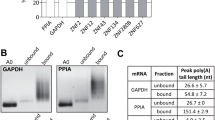Abstract
Chromosomal puffs on the polytene chromosomes in the dipteran Chironomus tentans offer the possibility of comparing the appearance of RNA-binding proteins at different transcription sites. We raised a monoclonal antibody that recognized a 130 kDa protein, designated hrp130. Immunocytological analysis of isolated chromosomes showed that hrp130 is heavily accumulated in a specific puff, called Balbiani ring 3; only occasionally is hrp130 abundant in one or two additional puffs on other chromosomes. The immunolabeling was sensitive to RNase treatment, suggesting that hrp130 is associated with nascent ribonucleoproteins. As shown by immunoelectron microscopy hrp130 is distributed along the active BR3 genes. The full sequence of hrp130 was determined by cDNA cloning. The protein comprises 1028 amino acids and contains three WW domains in the N-terminal half and six FF domains in the C-terminal half of the molecule. The protein is conserved from Caenorhabditis elegans to mammals; the human homolog is known as the transcription elongation repressor CA150. We propose that the abundance of hrp130/CA150 in BR3 is connected with the exceptionally high level of splicing in this locus and that hrp130/CA150 adjusts the transcription rate to the numerous splicing events taking place along the gene to ensure proper splicing.







Similar content being viewed by others
References
Abovich N, Rosbash M (1997) Cross-intron bridging interactions in the yeast commitment complex are conserved in mammals. Cell 89:403–412
Aebi M, Weissman C (1987) Precision and orderliness in splicing. Trends Genet 3:102–107
Allen M, Friedler A, Schon O, Bycroft M (2002) The structure of an FF domain from human HYPA/FB11. J Mol Biol 323:411–416
Alzhanova-Ericsson AT, Sun X, Visa N, Kiseleva E, Wurtz T, Daneholt B (1996) A protein of the SR family of splicing factors binds extensively to exonic Balbiani ring pre-mRNA and accompanies the RNA from the gene to the nuclear pore. Genes Dev 10:2881–2893
Baurén G, Belikov S, Wieslander L (1998) Transcriptional termination in the Balbiani ring 1 gene is closely coupled to 3′-end formation and excision of the 3′-terminal intron. Genes Dev 12:2759–2769
Bedford MT, Leder P (1999) The FF domain: a novel motif that often accompanies WW domains. Trends Biochem Sci 24:264–265
Beford MT, Chan DC, Leder P (1997) FBP WW domains and the Abl SH3 domain bind to a specific class of proline-rich ligands. EMBO J 16:2376–2383
Bentley D (1999) Coupling RNA polymerase II transcription with pre-mRNA processing. Curr Opin Cell Biol 11:347–351
Björkroth B, Ericsson C, Lamb MM, Daneholt B (1988) Structure of the chromatin axis during transcription. Chromosoma 96:333–340
Bohne J, Cole SE, Sune C, Lindman BR, Ko VD, Vogt TF, Garcia-Blanco MA (2000) Expression analysis and mapping of the mouse and human transcriptional regulator CA150. Mamm Genome 11:930–933
Burd CG, Dreyfuss G (1994) Conserved structures and diversity of functions of RNA-binding proteins. Science 265:615–621
Carty SM, Goldstrohm AC, Sune C, Garcia-Blanco MA, Greenleaf A (2000) Protein-interaction modules that organize nuclear function: FF domains of CA150 bind the phosphoCTD of RNA polymerase II. Proc Natl Acad Sci USA 97:9015–9020
Chen HI, Sudol M (1995) The WW domain of Yes-associated protein binds a proline-rich ligand that differs from the consensus established for Src homology 3-binding modules. Proc Natl Acad Sci USA 92:7819–7823
Daneholt B (2001) Assembly and transport of a premessenger RNP particle. Proc Natl Acad Sci USA 98:7012–7017
Daneholt B, Edström J-E (1967) The content of deoxyribonucleic acid in individual polytene chromosomes of Chironomus tentans. Cytogenetics 6:350–356
Dignam SS, Case ST (1990) Balbiani ring 3 in Chironomus tentans encodes a 185-kDa secretory protein which is synthesized throughout the fourth larval instar. Gene 88:133–140
Dreyfuss G, Matunis MJ, Pinol Roma S, Burd CG (1993) hnRNP proteins and the biogenesis of mRNA. Annu Rev Biochem 62:289–321
Ermekova KS, Zambrano N, Linn H, Minopoli G, Gertler F, Russo T, Sudol M (1998) The WW domain of neural protein FE65 interacts with proline-rich motifs in mena, the mammalian homolog of Drosophlia enabled. J Biol Chem 272:32869–32877
Fakan S (1994) Perichromatin fibrils are in situ forms of nascent transcript. Trends Cell Biol 4:86–90
Goldstrohm AC, Albrecht TR, Sune C, Bedford MT, Garcia-Blanco MA (2001) The transcription elongation factor CA150 interacts with RNA polymerase II and the pre-mRNA splicing factor SF1. Mol Cell Biol 21:7617–7628
Grasso C, Lee C (2004) Combining partial order alignment and progressive multiple sequence alignment increases alignment speed and scalability to very large alignment problems. Bioinformatics 20:1546–1556
Harlow E, Lane D (1988) Antibodies, a laboratory manual. Cold Spring Harbor Laboratory, Cold Spring Harbor, NY
Hirose Y, Manley JL (2000) RNA polymerase II and the integration of nuclear events. Genes Dev 14:1415–1429
Kabisch R, Bautz EKF (1983) Differential distribution of RNA polymerase B and nonhistone chromosomal proteins in polytene chromosomes of Drosophila melanogaster. EMBO J 2:395–402
Kao HY, Siliciano PG (1996) Identification of Prp40, a novel essential yeast splicing factor associated with the U1 small nuclear ribonucleoprotein particle. Mol Cell Biol 16:960–967
Kiseleva E, Wurtz T, Visa N, Daneholt B (1994) Assembly and disassembly of spliceosomes along a specific pre-messenger RNP fiber. EMBO J 13:6052–6061
Krämer A, Utans U (1991) Three protein factors (SF1, SF3 and U2AF) function in pre-splicing complex formation in addition to snRNPs. EMBO J 10:1503–1509
Krecic AM, Swanson MS (1999) hnRNP complexes: composition, structure, and function. Curr Opin Cell Biol 11:363–371
Lacroix JC, Azzouz R, Boucher D, Abbadie C, Pyne CK, Charlemagne J (1985) Monoclonal antibodies to lampbrush chromosome antigens of Pleurodeles waltlii. Chromosoma 92:69–80
Lei EP, Krebber H, Silver PA (2001) Messenger RNAs are recruited for nuclear export during transcription. Genes Dev 15:1771–1782
Lezzi M, Meyer B, Mähr R (1981) Heat shock phenomena in Chironomus tentans I. In vivo effects of heat, overheat, and quenching on salivary chromosome puffing. Chromosoma 83:327–339
Maniatis T, Reed R (2002) An extensive network of coupling among gene expression machines. Nature 416:499–506
Mattaj I (1993) RNA recognition: a family matter? Cell 73:837–840
Matunis EL, Matunis MJ, Dreyfuss G (1993) Association of individual hnRNP proteins and snRNPs with nascent transcripts. J Cell Biol 121:219–228
Morris DP, Greenleaf AL (2000) The splicing factor, Prp40, binds the phosphorylated carboxyl-terminal domain of RNA polymerase II. J Biol Chem 275:39935–39943
Morris DP, Lee JM, Sterner DE, Brickey WJ, Greenleaf AL (1997) Assaying CTD kinases in vitro and phosphorylation-modulated properties of RNA polymerase II in vivo. Methods Companion Methods Enzymol 12:264–275
Neubauer G, Gottschalk A, Fabrizio P, Seraphin B, Lührmann R, Mann M (1997) Identification of the proteins of the yeast U1 small nuclear ribonucleoprotein complex by mass spectrometry. Proc Natl Acad Sci USA 94:385–390
Neubauer G, King A, Rappsilber J, Calvio C, Watson M, Ajuk P, Sleeman J, Lamond A, Mann M (1998) Mass spectrometry and EST-database searching allows characterization of the multi-protein spliceosome complex. Nat Genet 20:46–50
Paulsson G, Lendahl U, Galli J, Ericsson C, Wieslander L (1990) The Balbiani ring 3 gene in Chironomus tentans has a diverged repetitive structure split by many introns. J Mol Biol 211:331–349
Pelling C (1964) Ribonukleinsäure-Synthese der Riesenchromosomen. Autoradiographische Untersuchungen an Chironomus tentans. Chromosoma 15:71–122
Pinol-Roma S, Choi YD, Matunis MJ, Dreyfuss G (1988) Immunopurification of heterogeneous nuclear ribonucleoprotein particles reveals an assortment of RNA-binding proteins. Genes Dev 2:215–227
Pinol-Roma S, Swanson MS, Gall JG, Dreyfuss G (1989) A novel heterogeneous nuclear RNP protein with a unique distribution on nascent transcripts. J Cell Biol 109:2575–2587
Proudfoot NJ, Furger A, Dye MJ (2002) Integrating mRNA processing with transcription. Cell 108:501–512
Roth MB, Gall JG (1987) Monoclonal antibodies that recognize transcription unit proteins on newt lampbrush chromosomes. J Cell Biol 105:1047–1054
Saitou N, Nei M (1987) The neighbor-joining method: a new method for reconstructing phylogenetic trees. Mol Biol Evol 4:406–425
Sommerville J, Crichton C, Malcolm D (1978) Immunofluorescent localization of transcriptional activity on lampbrush chromosomes. Chromosoma 66:99–114
Strässer K, Masuda S, Mason P, Pfannstiel J, Oppizzi M, Rodriguez-Navarro S, Rondon AG, Aguilera A, Struhl K, Reed R, Hurt E (2002) TREEX is a conserved complex coupling transcription with messenger RNA export. Nature 417:304–307
Sudol M, Chen HI, Bougeret C, Einbond A, Bork P (1995) Characterization of a novel protein-binding module—the WW domain. FEBS Lett 369:67–71
Sun X, Alzhanova-Ericsson AT, Visa N, Aissouni Y, Zhao J, Daneholt B (1998) The hrp23 protein in the Balbiani ring pre-mRNA particles is released just before or at the binding the particles to the nuclear pore complex. J Cell Biol 142:1181–1193
Sune C, Garcia-Blanco MA (1999) Transcriptional cofactor CA150 regulates RNA polymerase II elongation in a TATA-box-dependent manner. Mol Cell Biol 19:4719–4728
Sune C, Hayashi T, Liu Y, Lane W, Young RA, Garcia-Blanco MA (1997) CA150, a nuclear protein associated with RNA polymerase II holoenzyme, is involved in Tat-activated human immunodeficiency virus type 1 transcription. Mol Cell Biol 17:6029–6039
Visa N, Alzhanova-Ericsson AT, Sun X, Kiseleva E, Björkroth B, Wurtz T, Daneholt B (1996) A pre-mRNA-binding protein accompanies the RNA from the gene through the nuclear pores and into polysomes. Cell 84:253–264
Wetterberg I, Baurén G, Wieslander L (1996) The intranuclear site of excision of each intron in Balbiani ring 3 pre-mRNA is influenced by the time remaining to transcription termination and different excision efficiencies for the various introns. RNA 2:641–651
Wetterberg I, Zhao J, Masich S, Wieslander L, Skoglund U (2001) In situ transcription and splicing in the Balbiani ring 3 gene. EMBO J 20:2564–2574
Wieslander L (1994) The Balbiani ring multigene family: coding repetitive sequences and evolution of a tissue-specific cell function. Prog Nucleic Acid Res Mol Biol 48:275–313
Wurtz T, Kiseleva E, Nacheva G, Alzhanova-Ericsson AT, Rosén, A, Daneholt B (1996) Identification of two RNA-binding proteins in Balbiani ring premessenger ribonucleoprotein granules and presence of these proteins in specific subsets of heterogeneous nuclear ribonucleoprotein particles. Mol Cell Biol 16:1425–1435
Wyss C (1982) Ecdysterone, insulin and fly extract needed for the proliferation of normal Drosophila cells in defined medium. Exp Cell Res 139:297–307
Zarrinpar A, Lim WA (2000) Converging on proline: the mechanism of WW domain peptide recognition. Nat Struct Biol 7:611–613
Acknowledgements
We thank Lars Wieslander for providing us with Chironomus tentans cDNA libraries. The anti-RNA polymerase II antibody was a gift from Arno L. Greenleaf (Duke University Medical Center, Durham, N.C.). We are grateful to Sergej Masich for computer support and to Birgitta Björkroth and Lise-Marie Fjelkestam for technical assistance. This study was supported by the Swedish Research Council, Human Frontier Science Program Organization, Knut and Alice Wallenberg Foundation, Kjell and Märta Beijer Foundation, Ingabritt and Arne Lundberg Foundation and the Karolinska Institute Research Funds.
Author information
Authors and Affiliations
Corresponding author
Additional information
Communicated by U. Scheer
Rights and permissions
About this article
Cite this article
Sun, X., Zhao, J., Kylberg, K. et al. Conspicuous accumulation of transcription elongation repressor hrp130/CA150 on the intron-rich Balbiani ring 3 gene. Chromosoma 113, 244–257 (2004). https://doi.org/10.1007/s00412-004-0314-4
Received:
Revised:
Accepted:
Published:
Issue Date:
DOI: https://doi.org/10.1007/s00412-004-0314-4




